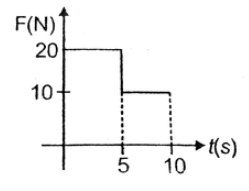An object of mass 3kg is at rest. Now a force of →F=6t2ˆI+4tˆj is applied on the object, the velocity of object at t=3s is.
18ˆj+3ˆj
18ˆi+6ˆj
3ˆi+18ˆj
18ˆi+4ˆj
The correct Answer is:B
To solve the problem step by step, we will follow the principles of Newton's laws of motion and calculus.
Step 1: Identify the given information
- Mass of the object, m=3kg
- Force applied, →F=6t2^i+4t^j
- Time, t=3s
Step 2: Calculate the acceleration
Using Newton's second law, we know that:
→F=m→a
Thus, the acceleration →a can be calculated as:
→a=→Fm=6t2^i+4t^j3
Simplifying this gives:
→a=2t2^i+43t^j
Step 3: Integrate acceleration to find velocity
Since acceleration is the derivative of velocity with respect to time, we can write:
→a=d→vdt
Integrating both sides with respect to time t:
→v=∫→adt=∫(2t2^i+43t^j)dt
This gives us:
→v=(23t3^i+23t2^j)+→C
Where →C is the constant of integration. Since the object is at rest initially, →v(0)=0, we find that →C=0.
Step 4: Substitute t=3s into the velocity equation
Now we substitute t=3 into the velocity equation:
→v=(23(33)^i+23(32)^j)
Calculating this gives:
→v=(23⋅27^i+23⋅9^j)=(18^i+6^j)
Final Answer
Thus, the velocity of the object at t=3s is:
→v=18^i+6^j
- Mass of the object, m=3kg
- Force applied, →F=6t2^i+4t^j
- Time, t=3s
Using Newton's second law, we know that:
→F=m→a
Thus, the acceleration →a can be calculated as:
→a=→Fm=6t2^i+4t^j3
Simplifying this gives:
→a=2t2^i+43t^j
Since acceleration is the derivative of velocity with respect to time, we can write:
→a=d→vdt
Integrating both sides with respect to time t:
→v=∫→adt=∫(2t2^i+43t^j)dt
This gives us:
→v=(23t3^i+23t2^j)+→C
Where →C is the constant of integration. Since the object is at rest initially, →v(0)=0, we find that →C=0.
Now we substitute t=3 into the velocity equation:
→v=(23(33)^i+23(32)^j)
Calculating this gives:
→v=(23⋅27^i+23⋅9^j)=(18^i+6^j)
Thus, the velocity of the object at t=3s is:
→v=18^i+6^j
Similar Questions
An object of mass 3 kg is at rest . Now a force F=6t2ˆi+2tˆj is applied on the object . Find the velocity of the object at t =3 sec.
View SolutionAn object of mass 2 kg at rest at origin starts moving under the action of a force
→F=(3t2ˆi+4tˆj)N The velocity of the object at t = 2 s will be -
View Solution
Knowledge Check
A body with mass 5 kg is acted upon by a force →F=(−3ˆi+4ˆj)N. If its initial velocity at t =0 is →v=6ˆi−12ˆjms−1, the time at which it will just have a velocity along the y-axis is :
A0B10sC2sD15s
A body with mass 5 kg is acted upon by a force →F=(−3ˆi+4ˆj)N. If its initial velocity at t =0 is →v=(6ˆi−12ˆj)ms−1, the time at which it will just have a velocity along the y-axis is :
View SolutionA body with mass 5 kg is acted upon by a force →F=(−3ˆi+4ˆj)N. If its initial velocity at t =0 is →v=6ˆi−12ˆjms−1, the time at which it will just have a velocity along the y-axis is :
View SolutionA body of mass 1kg begins to move under the action of a time dependent force →F=(2tˆi+3t2ˆj)N, where ˆi and ˆj are unit vectors along x-and y-axes. What power will be developed by the force at the time t ?
View SolutionForce is applied on an object of mass 2 kg at rest on a frictionless horizontal surface as shown in the graph. The speed of object at t=10 s will be

View SolutionThe displacement s of an object is given as a function of time t by the following equation s=2t+5t2+3t3. Calculate the instantaneous velocity of the object at t = 1 s.
View SolutionThe displacement x of an object is given as a function of time x=2t+3t2
Calculate the instantaneous velocity of the object at t = 2 s
View SolutionThe displacement x of an object is given as a funstion of time, x=2t+3t2. The instantaneous velocity of the object at t = 2 s is
View Solution
